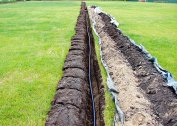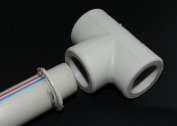Hot water entering the apartments in central heating networks before use requires cleaning. Heating systems are highways made of steel pipe, which gradually begins to corrode under the influence of high temperature and water. Particles of rust, as well as grains of welds, get into hot water. Plus, to the negative factors, you can add scum, which covers the walls of the pipes and comes off with small plates. The filter can fix this problem.
Hot water filters
Purely constructive filters for hot water are no different from devices for cold water supply. But their designs use materials that can withstand high temperatures and not corrode. Devices are made of stainless steel, cast iron (common-house filters) or heat-resistant plastic.
Cartridge-type constructions also use stainless steel or polymer compositions, which under the influence of temperatures do not change their technical characteristics.
Varieties of filters
Basically in apartments and private houses, flow main filters for hot water are installed. They got their name only because they cut directly into the water pipe - into the supply line. On the market they are represented by two modifications:
- mesh;
- cartridge.
Devices differ from each other by a filtering element. In the first case, it is a grid rolled into a cylinder and placed in a flask. In the second, it is a polymer fiber cartridge, which is enclosed in a cylindrical perforated body. The latter is placed in the flask of the device.
Mesh
Devices belong to the category of filters for rough cleaning of hot water. With their help, there is a delay of large mechanical impurities. Typically, these devices are installed at the entrance to an apartment or house in front of a hot water meter. Thus, the water meter is immediately protected.
The simplest version is a model in which there is a cavity where a grid in the form of a cylinder is installed. But at the same time, it closes the duct of water movement with its upper part. Such filters are called mud collectors, because all impurities retained by the filter element settle to the bottom of this cavity, where dirt is formed. The cavity may be perpendicular to the main duct or at an angle.
The second variety is bulb. The upper part with the main duct runs into a hot water pipe. A flask is screwed vertically onto it from below from below, into which a mesh cylinder is installed.
Flask devices require frequent flask cleaning and washing the filter element, which causes a lot of trouble. Therefore, manufacturers began to offer self-cleaning designs. They differ from the standard ones in that a tap on the nozzle is installed at the bottom of the flask. In order to flush the mesh cylinder and let out the mud sediment, it is necessary to open the faucet through which the dirty water will start to flow. The flask will begin to fill with clean water. The more fluid that passes through the mesh, the cleaner it will become. To facilitate the cleaning procedure, the faucet is connected with a hose to the sewage system.
Manufacturers offer self-cleaning models with automatic cleaning. They work from the pressure difference inside the device. As soon as the mesh becomes clogged with mechanical particles, water will pass through it poorly. In the supply pipe, pressure and, accordingly, pressure will decrease immediately. The tap will open itself from the pressure drop and the filter will be flushed.
Screen filters are simple in terms of design, but they work efficiently. Their service life is quite large. In addition, the mesh can always be washed.
Cartridge
This variety can be attributed to the category of fine filters for hot water, because the devices trap even the smallest particles. It all depends on the filter element, its density, but many manufacturers guarantee a fairly high degree of purification. As a filter element, they use polymer fibers, which do not react in any way to water and high temperature. The only drawback of such devices is the inability to wash cartridges. If it is clogged, and it is easy to recognize this by the drop in pressure and volume of water, it is simply replaced with a new one.
Cartridge filters for hot water can be installed at the entrance to the apartment or house, in front of the meter. To do this, it is better to purchase models with a low density of polymer fibers. You can install directly in front of the consumer. To do this, it is better to use models with a dense filter element. Typically, such modifications are mounted in the bathrooms in front of the washing machines.
Installation Features
Installing filters for hot water is no different from installing flow-through models of a different type. The connection is made through American - removable couplings on the thread. This is a convenient option because there is always a need for replacement or repair.
The assembly process itself is based on welding one part of the American women to a hot water pipe. The second part is screwed into the pipe of the filter itself, after which the device inserted between the two ends of the pipe is connected to them using the parts of the couplings screwed into each other. The main task of the manufacturer is to accurately transfer the length between the ends of the oppositely located nozzles to the hot water pipeline. This parameter is in the product passport, nothing needs to be measured.
Other requirements:
- free access to the filter, nothing should interfere with the cleaning, repair or replacement of the device;
- bulb constructions must be attached to the wall with two self-tapping screws on plastic dowels;
- the vertical location of the bulb is an important condition that ensures the correct operation of the filter;
- the volume of the flask and the diameter of the connecting pipes are selected according to the diameter of the mounted hot water pipe.
All joints are sealed. To screw an American into the device nozzles use a fum tape. Between the parts of the couplings, rubber gaskets are installed.
Criterias of choice
The choice will depend on what quality hot water flows through the pipes, and what requirements the owners of the apartment will make to it. If the water is hard, it is better to purchase a filter with an additional softening function.
The second criterion is power or throughput. To do this, multiply the number of residents by the standard value of hot water consumption. This parameter is 5-8 liters per day.
The third criterion is the availability of a quality certificate. Many buyers neglect this document. However, its presence is a guarantee of quality, which confirms the authenticity of the product. Well, if the package includes a warranty card.





